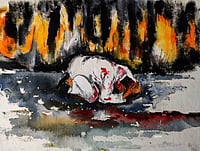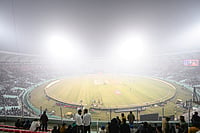In 1999, the then ruling Left Front government of West Bengal wrote to the Ministry of Information and Broadcasting in Delhi asking for permission to set up a TV channel. The request was rejected on several very sensible grounds. The first was the Supreme Court judgment of 1995 which had freed the airwaves from government control, arguing that 'government control in effect means the control of the political party or parties in power for the time being' and was bound to colour free expression. Second, such a propaganda channel would distort the level playing field between political parties. Besides, it would have opened a Pandora's Box of various public-funded bodies and political parties wanting their own personal channels.
The official request may have been denied but the Communist Party of India (Marxist) (CPI-M) was not to be thwarted. If it was to be denied a government-owned TV channel, it would get a party-controlled one. Just before the 2001 assembly election, Aakash Bangla was launched with funds from city businessmen and with the CPI-M's media face Avik Dutta as its managing director. The idea reportedly came from Anil Biswas, then party secretary in West Bengal, and Aakash Bangla started life as one of the first politically coloured TV networks in the state.23 But the story soon got even more interesting.
By 2006, Zee News, looking to shore up its expansion into eastern India, decided to join hands with the avowedly CPI-M men who seemed to control private television in the state. Zee News bought a majority stake in a joint venture with CPI-M man Avik Dutta's company, which controlled 24 Ghanta. The channel began life as a twenty-four-hour news channel with content and staff from Aakash Bangla and cash from Zee. It was launched with an exclusive telecast of the CPI-M's state committee meeting and pitched itself as a more balanced network, but it was headed by a CPI-M loyalist and observers noted that it never took sides against the party on any critical issue.
Two years later, Zee News took a step further and purchased a significant minority stake in the parent company that owned Aakash Bangla as well. These two deals were meant to cement its move into eastern India and emerge as a major television player in Bengal. They also locked in a complex strategic partnership between a publicly listed company whose promoter was once a member of the right-wing RSS and media outfits widely believed to be influenced by a communist party.
Zee's business moves were not ideological. These were tactical business alliances to further its viewing reach, irrespective of the politics of its news partners. The best illustration of this is the story of Zee in Andhra Pradesh, where it explored yet another politically loaded deal, this time with a Congress leader. Plagued by losses in its Telugu news channel, Zee Ghantalu, the company announced in August 2012 that it was closing it down. Channel officials pointedly told journalists that Zee Ghantalu would be shut down because its fourteen other competitors in the state were 'politically driven' and it did 'not make sense to continue' in such a market.
Yet, within weeks, newspapers were reporting that a deal had been struck. Instead of closing down, Zee would sell a major share in the channel to the family of Andhra Congress president Botcha Satyanarayana. The minister confirmed that his brother, a cable operator, would buy a controlling stake and assume control, while Zee would retain a minority share. Eventually, in January 2014, Zee finally shut Ghantalu down to relaunch it in a new avatar for the Oriya market, as Zee Kalinga.
These alliances are typical of the way several business houses operating in the TV space function at the ground level, given the subtle kinds of political influence exercised at the ground level by local political leaders. They are only a micro example, and a more benign one at that, of the larger trends within the news industry.
As a genre, news attracts just about 7 per cent of viewership in India and one-fifth of television advertising. Yet, almost half of over 800 licensed TV channels in the country are news channels, and one-third of these beam twenty-four-hour news. This is a bizarrely high ratio compared to other countries. Especially so when everyone in the industry agrees that news channels have turned into financial black holes and enjoy a negligible market share. Yet, more and more news channels keep getting launched and more and more money keeps getting pumped into them. Why?
The hard truth is that hardly any news channel in India makes money. With the exception of a handful of channels, most news channels have never made any money across their whole life cycles. Financially, the business of TV news is so broken that if you were to invest your money in a fixed deposit, you would probably make more money than if you invested it in a news channel. As filmmaker Prakash Jha, who started Maurya TV in Bihar, told an interviewer, 'I was crazy to have entered the media business. It was the love for my state that inspired me to launch the channel. But I am bleeding right now. My revenues don't even cover one-third of the cost of running it.' Jha himself fought an election in 2009, of course, and Maurya TV was eventually sold. In early 2014, Zee Media relaunched it as Zee Purvaiya in Bihar and Jharkhand.
Three kinds of people have invested substantially in news television in the past decade: politicians, real estate, chit fund and money market companies and large corporations. This trend is now so pervasive that these three categories of owners now have deep stakes in the majority of the news TV business in most Indian states. My research shows that between them such companies make up over 80 per cent of the news TV business in Andhra, Karnataka and Odisha and around 60 –70 per cent in Punjab, Maharashtra West Bengal, Tamil Nadu and the north-east (see Figure 1.3). A decade ago, only a handful of states like Tamil Nadu had channels like Sun TV or Jaya TV, which were basically set up as propaganda arms of rival political parties. Now, this is the norm across India.
The first lot, politicians, got into the business for obvious reasons, mainly to gain a fixed platform to relay their messages to voters. In Andhra Pradesh, only two or three of the fourteen news channels are not controlled by politicians or their proxies. The growth in news channels is not being driven by companies looking to create new platforms for objective, serious coverage but by power players looking to spread their own propaganda and their own views. From Sakshi TV of Jagan Reddy of the YSR Congress to Captain TV of the Tamil actor Vijaykanth, it is now almost an unwritten rule in politics for new entrants to announce their arrival by first launching their own TV channel.
By itself, this should not necessarily be a problem. Politicians have as much of a right to free speech as everyone else and, in theory at least, each propaganda voice should cancel each opposing voice out. The trouble is twofold. First, it completely loads the democratic field in favour of those political players with access to big under-the table funding and drives out less wealthy players. Second, the easy money that politicians have brought into the game has completely distorted the market and is virtually driving out all serious, neutral players out of it. In a market where virtually no one made money anyway, the arrival of new rivals abuzz with wads of fresh cash and no need to meet bottom lines can only squeeze out genuine players or force them to make dubious alliances to survive.
This partly explains some the alliances made by Zee and this is also why many serious institutional investors, with no political axe to grind, are now reluctant to invest in the news business. Some of those that did invest are getting out.
As one such investor, who had invested heavily in the news TV business in Andhra, told a newspaper reporter: 'What began as an opportunity has become a liability. There are too many news channels in the market, mostly run in an unprofessional manner by owners who have interests beyond media.' And there is, of course, the obvious question of what happens to news when 'politicians convert the newsroom into their party office', as one news editor put it?
Importantly, it is not just about owning networks. One of the least analysed ways through which politicians control the news is by controlling cable operators. States like Chhattisgarh and Punjab have evolved their own model where television is controlled by the ruling party through its own private TV networks, as well as a cartelization of the cable industry. In Chhattisgarh, for example, broadcast journalists encountered a very peculiar kind of censorship during the run-up to the state's first election in 2003. Every time any of the news channels broadcast a news item that was even mildly critical of then chief minister Ajit Jogi, it was blanked from the air. Chhattisgarh viewers watching that particular broadcast would suddenly find their television sets going blank and the transmission would return only fifteen minutes or so after the offending news story was over. This unannounced censorship would happen only within the territorial boundaries of Chhattisgarh and television viewers in the rest of India did not encounter this problem at all.
This was because supporters of the chief minister had set up a statewide private television network, Akash TV, that bought over, or took control of, cable distribution networks across Chhattisgarh and this provided an easy mechanism for controlling the broadcast of national news channels within the state's borders. The national networks could be turned off each time their news reportage did not suit the ruling establishment. It was an ingenious form of censorship: it wasn't officially announced, it technically did not come from the state and there was nothing any of the channels could do about it. The uses, or misuses, of Akash Television became an important part of the BJP's electoral campaign against Jogi in 2003 and within hours of his losing power on 4 December, its television studios were taken over by a triumphant crowd of the party's supporters.
Similarly, in Punjab, the first thing that the Badal family did on first returning to power in 2007 was to start their own PTC television network (owned through a complex web of companies) and take over control of cable companies which distributed television. In August 2007, the Cable Operators Federation of India complained to the Ministry of Information and Broadcasting of physical threats and arrests of cable operators in the state. Like Jogi in Chhattisgarh, Sukhbir Singh Badal, president of the Shiromani Akali Dal denied the charges but the parallels were undeniable.
Before the Akalis came to power, the Congress chief minister Amarinder Singh, had patronized the Punjab Today channel. Within hours of his losing the election in 2007, this channel went into oblivion and many cable operators in the state were forced to replace it with the new Akali-friendly channel PTC on their prime frequencies. Detractors complained that any channel that broadcast anti-Badal stories would be blanked off. As one cable operator from Patiala said after being released from prison on charges of violence, 'This is state terror being used against us and the police are being used freely and scores of false cases are being filed.'
By mid-2013, things had reached such a pass that when the managing editor of the Punjab news channel Day and Night News resigned; he did so after publicly blaming his channel's financial problems on a 'powerful political entity in Punjab', which aimed at snuffing out 'fair and free journalism'. In a speech to his employees on YouTube, he sarcastically congratulated the politicians and 'a group of news and entertainment channels … behind the cartel that controls the cable network in Punjab' for succeeding in driving them out. In his view, Day and Night News failed financially because the dominant cable company in the state, Fastway, which controlled 85 per cent of subscribers, had been 'abusing its dominance to deny us access to the Punjab market'. This was not just an empty accusation; it was also upheld by the Competition Commission of India, which a year earlier had imposed a hefty fine on the cable network for denying access to Day and Night News. Yet, the end result was that the news channel was driven to the ground.
Power and television were intrinsically combined in this Punjab model. The PTC network became popular not just by forcing cable operators to relay it, but by getting the rights to broadcast live daily gurbani from the Golden Temple overnight. These rights had been sold to another channel, ETC Punjabi, for eleven years but were transferred in deal with PTC overnight once the Akali Dal came to power.44 Along with this, despite being so new, PTC received a large amount of state advertising – Rs 78 lakh in its first year of operations – from a government controlled by the Badal family. Badal has denied allegations of favouritism but other channels seem to have got similar amounts only over five years. The Competition Commission of India ultimately registered a case against the cartelization, calling it an 'unfair trade practice'. Similarly, there were over twenty cases being examined by TDSAT and TRAI. Yet, Congress accusations against the Akalis of cable control sound hollow, as they had done precisely the same thing when in power.
(The second part of this book extract will appear tomorrow)





















